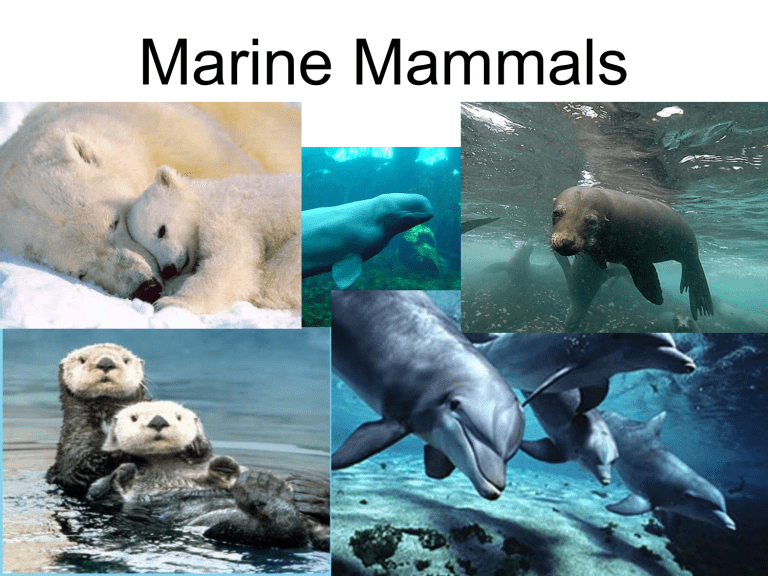Marine Mammals

Marine Mammals
What is a Mammal?
• Mammals have a 4 chambered heart.
• Mammals are warmblooded.
• They have hair/fur.
• Have mammary glands.
• Give birth to live young.
Pinnepeds
• Pinnepeds are marine mammals that have flippers and blubber, that need to breed on land.
• Seals, Walruses, and Sea Lions all belong to this Order.
• Pinnepeds live in cold water, they have a thick layer of blubber to keep them warm.
• They are mostly carnivores and feed on squid and fish.
• They have streamlined bodies and are excellent swimmers.
• Seals are the largest group of pinnepeds.
Seals
• Seals have rear flippers.
• They move forward by pulling themselves along the ground.
• Seals do not have ear flaps.
• They are hunted for their fur and are protected by the
Marine Mammal Protection
Act of 1972.
• There are approximately 19 species of Seals.
Sea Lions
• Are also called Eared Seals, because they have external ear flaps.
• They can move their rear flippers forward to walk.
• They are graceful and agile swimmers.
• These are the “guys” that you see at Marine World or an Aquarium doing neat tricks and they also work for the US Navy!
• At one time they were hunted for their fur, but are now protected by the MMPA of 1972.
Walruses
• Have large protruding tusks for digging up mollusks. They love to eat clams!
• They have stiff whiskers for feeling around on the ocean floor.
• They are the largest
Pinneped, weighing up to 2700 lbs!
Sea Otters
• Are members of the Order Carnivora.
• They are the smallest Marine Mammal, weighing
60-80 lbs.
• They lack a layer of blubber, and make up for it by trapping air in their dense fur.
• They were slaughtered to the brink of extinction for their beautiful fur, but became protected by an international agreement in 1911.
• They are playful, and intelligent.
• They eat mostly shell fish and spend most of the day maintaining their fur.
Polar Bears
• Is the second member of the order
Carnivora that is a Marine Mammal.
• They are semi aquatic, and inhabit both the land and the sea.
• They feed primarily on seals.
• They have recently been put on the endangered species list because of loss of habitat due to global warming.
Cetaceans
• This is the largest group of Marine Mammals, consisting of Whales , Dolphins, and
Porpoises.
• These, of all the Marine Mammals, have made the most complete transition to aquatic life.
• These animals spend their entire lives in the water.
• They are streamlined, and look remarkably fish-like.
• They breathe air through lungs and have nostrils on the tops of their heads called a blowhole (some single, some double).
• There are more than 90 species of
Cetaceans.
• They are divided into two groups: toothed
Whales (which includes Dolphins and
Porpoises), and toothless Whales which have a Baleen.
• Instead of teeth, Baleen Whales have rows of flexible, fibrous plates, that hang from the upper jaws (called a Baleen). These are used to filter out plankton and tiny organisms from the water.
• Baleen Whales are the largest animals to ever have lived on this planet.
• There are 13 species of Baleen Whales, the
Blue Whale being the largest at up to 110 ft. long, and up to 200 tons.
• The remaining 80 species of Cetaceans are toothed Whales.
• Their teeth are adapted for a diet of squid, fish, and other prey.
• Teeth are used to catch and hold prey, not to chew it.
• The largest of the toothed Whales is the
Sperm Whale, made famous by the novel
“Moby Dick”.
• Killer Whales, or Orcas, are beautiful black and white Whales that are predators, eating seal, penguins, sea otters, and fish.
• They are more common in cold water, but are found round the world.
• Dolphins are highly intelligent creatures, and can be easily trained..
• They are very playful, and have been known to “escort” ships for miles at a time.
• Porpoises are really blunt nosed smaller
Whales.
• Dolphins, Porpoises, and Whales travel in groups called Pods.
• They are protected by the MMPA of 1972, but are still hunted.
• The Japanese, and Norwegian fishing
Industries have been illegally whaling under false pretenses ( scientific whaling).
• It is common for Cetaceans to get caught in fishing nets meant for other species.
Communication
• One way Cetaceans communicate is through
Echolocation.
• They release tiny bubbles through their blowholes and make clicking sounds to communicate with each other and determine distances, and warn others about danger.
• This is natures version of Sonar.
• The Melon (fatty structure on the top of their heads) focuses and directs these sound waves.
• Cetaceans produce a rich variety of sounds tha are associated with different moods, sexual signaling, feeding, alarms……
Breaching
• When Whales leap in the air and loudly crash on the surface of the water.
• This can be a warning signal, getting rid of external parasites, fun, or a way of scanning the surface.
Let’s go to the Video!
QuickTime™ and a
Sorenson Video 3 decompressor are needed to see this picture.











